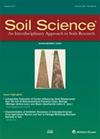寒冷沙漠早期土壤发育过程中的磷动态:来自磷酸盐氧同位素的见解
4区 农林科学
Q2 Agricultural and Biological Sciences
引用次数: 1
摘要
摘要在成土作用的早期阶段,土壤中磷的动态受微生物群落、土壤理化性质和环境条件的控制。虽然已经确定了参与生物地球化学过程的各种微生物,但对微生物过程(如有机磷水解和微生物磷周转)对磷循环的实际贡献知之甚少。因此,我们重点研究了微生物驱动的过程,以及它们如何影响Chamser kang - ri冰川前田(西喜马拉雅)土壤时间序列中有机和无机土壤P库的大小和循环。冰川的迅速退缩使我们能够研究寒冷干旱气候下土壤形成的早期阶段。通过对4个不同年龄(0 ~ 100 ~ 150年)土壤样品(0 ~ 5 cm深)的磷同位素组成(δ18OP)和顺序磷分馏,研究了生物磷转化。土壤发育约100年后,与Ca结合的磷,即1 M盐酸可提取的磷,仍占总磷储量的95%。其同位素组成与最发达地点的母质相似。原生磷酸盐矿物,可能是磷灰石,主要组成了这个池。有效磷和naoh可萃取无机磷的δ18OP与母质的δ18OP不同,表明这些池经历了生物周转。速效磷的δ18OP主要由微生物磷控制,表明这两个库之间发生了快速交换,可能是由反复的冻融和干再湿循环促进的。有机磷在土壤中的释放越来越重要,在最古老的土壤中占有效磷通量的三分之一。因此,在最古老的地点,与铁和氧结合的P同位素组成较轻,表明该池含有有机P矿化释放的磷酸盐。与以往关于高山或寒冷气候下早期土壤形成的研究相比,我们的研究结果表明,在极端条件下土壤发育的前100年,含磷原生矿物的减少速度要慢得多。然而,他们提供的证据表明,通过驱动短期磷动态,微生物在控制初级磷向无机和有机土壤库的再分配中发挥了重要作用。本文章由计算机程序翻译,如有差异,请以英文原文为准。
Phosphorus dynamics during early soil development in a cold desert: insights from oxygen isotopes in phosphate
Abstract. At the early stages of pedogenesis, the dynamics of phosphorus (P)
in soils are controlled by microbial communities, the physicochemical
properties of the soil and the environmental conditions. While various
microorganisms involved in carrying out biogeochemical processes have been
identified, little is known about the actual contribution of microbial
processes, such as organic P hydrolysis and microbial P turnover, to P
cycling. We thus focused on processes driven by microbes and how they affect
the size and cycling of organic and inorganic soil P pools along a soil
chronosequence in the Chamser Kangri glacier forefield (Western Himalayas).
The rapid retreat of the glacier allowed us to study the early stages of
soil formation under a cold arid climate. Biological P transformations were
studied with the help of the isotopic composition of oxygen (O) in phosphate
(δ18OP) coupled to sequential P fractionation performed on
soil samples (0–5 cm depth) from four sites of different age spanning 0 to
100–150 years. The P bound to Ca, i.e., 1 M HCl-extractable P,
still represented 95 % of the total P stock after approximately 100 years of soil
development. Its isotopic composition was similar to the parent material at
the most developed site. Primary phosphate minerals, possibly apatite,
mostly comprised this pool. The δ18OP of the available P
and the NaOH-extractable inorganic P instead differed from that of the
parent material, suggesting that these pools underwent biological turnover.
The δ18OP of the available P was mostly controlled by the
microbial P, suggesting fast exchanges occurred between these two pools
possibly fostered by repeated freezing–thawing and drying–rewetting cycles.
The release of P from organic P becomes increasingly important with soil
age, constituting one-third of the P flux to available P at the oldest site.
Accordingly, the lighter isotopic composition of the P bound to Fe and Al
oxides at the oldest site indicated that this pool contained phosphate
released by organic P mineralization. Compared to previous studies on early
pedogenesis under alpine or cold climate, our findings suggest a much slower
decrease of the P-bearing primary minerals during the first 100 years of
soil development under extreme conditions. However, they provide evidence
that, by driving short-term P dynamics, microbes play an important role in
controlling the redistribution of primary P into inorganic and organic soil
P pools.
求助全文
通过发布文献求助,成功后即可免费获取论文全文。
去求助
来源期刊

Soil Science
农林科学-土壤科学
CiteScore
2.70
自引率
0.00%
发文量
0
审稿时长
4.4 months
期刊介绍:
Cessation.Soil Science satisfies the professional needs of all scientists and laboratory personnel involved in soil and plant research by publishing primary research reports and critical reviews of basic and applied soil science, especially as it relates to soil and plant studies and general environmental soil science.
Each month, Soil Science presents authoritative research articles from an impressive array of discipline: soil chemistry and biochemistry, physics, fertility and nutrition, soil genesis and morphology, soil microbiology and mineralogy. Of immediate relevance to soil scientists-both industrial and academic-this unique publication also has long-range value for agronomists and environmental scientists.
 求助内容:
求助内容: 应助结果提醒方式:
应助结果提醒方式:


